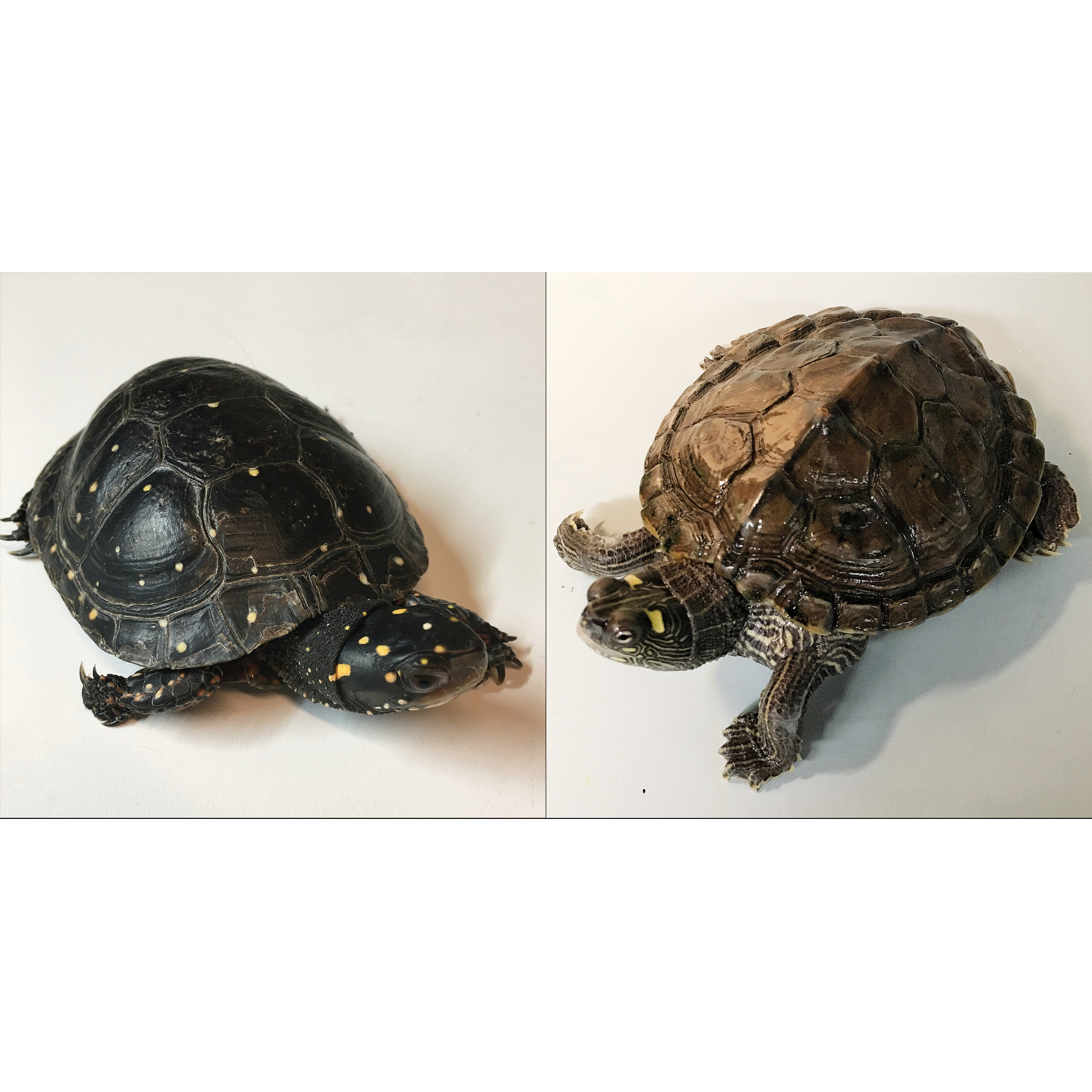This is a story about homelessness, a scourge that afflicts pets as well as people. When we bring animals into our homes they become our captives, for better or worse. Their lives are dictated by our whims and circumstances. Too many turtles know something of this. Often kidnapped from their native homes and continually rejected and resettled over the courses of their long lives, they are at our mercy. Their stories seldom end well. This, however, is a rare exception.
Once upon a time a beautiful, male spotted turtle in his prime was tragically taken from the wild. When his captors tired of keeping him he was dumped, anonymously, at an urban school. The principal, recognizing a protected species, brought him here in the hopes that we could find appropriate placement for him. Being of unknown origin and with a history of captivity, he would sadly never be able to return to his wild home to carry on his wonderful genetics, as the risk of his carrying disease instead was now too great.
With no legally permitted facility in the market for a spotted at that time, an arrangement was made to have the turtle fostered by the Special Education Department at a local elementary school, where he served as an ideal reading buddy and received impeccable care while awaiting permanent placement. “Mikey” became a beloved member of his new population, a classroom of emotionally and developmentally challenged kids. Staff reported that his presence benefited his new friends—many of whom will never have a pet—in immeasurable ways.
When the call came late last year that the Bruce Museum in Greenwich, Connecticut was in search of a spotted turtle, it presented a conundrum. Being offered such an ideal placement for an unreleasable, listed species is commensurate with having your number finally called for an organ transplant. Yet how could we, in good conscience, sever the bond that had formed between those special needs children and this little fellow, especially at a time when their lives had already been so destabilized by the pandemic? None of our adoptable rescue turtles were small enough to take his place in the limited available classroom tank space.
Meanwhile, as news of the looming eviction crisis joined the daily pandemic alarms, a message appeared on Facebook as if to illustrate the truth of that prediction. A woman in a nearby town had recently been evicted and had taken her pet map turtle with her. The pair had been surviving in her car for thirteen of the coldest days in December. So devoted was she to this common, captive-bred little turtle that its entire tank and furnishings were taking up precious real estate in her car, and she was providing water for him using a ceramic bowl. Precarious as her situation was, life had another blow in store; she suddenly required long-term hospitalization, and the turtle needed immediate rescue.
Dealing with the sheer volume of unwanted pet turtles around us is one of the most frustrating, expensive and no-win aspects of being a turtle rehabilitator, and we often have to say no. To find someone so dedicated to a turtle that they won’t part with it—even when dealing with one of life’s most dire emergencies—is stunningly rare. With no plan other than a compelling need to honor this commitment, we rescued the turtle that evening with the help of some very good Samaritans.
It was as though fate had intervened on everyone’s behalf. The map turtle, whom we expected might need medical care after his freezing ordeal, lived up to the robust reputation of his species. He was perfectly healthy…and exactly the right size to replace the spotted. The timing couldn’t have been better; not only did these two circumstances arise simultaneously, but transfer was able to take place during the holiday break, smoothing the transition for the students. Mikey has embarked upon his new adventure at the museum, and “Shelly,” as the map turtle has been affectionately dubbed, has been wholly embraced by his new elementary school family. Both animals found not only ideal new homes, but also new and important roles as educational ambassadors. And, if karma holds true, a woman who went to heroic lengths to save her turtle during an ordeal brought on by a pandemic will have the relief of knowing that he is settled and beginning a new chapter.
Good outcomes are hard to come by when it comes to placing dispossessed turtles. It’s not the job we sign up for when we become rehabilitators, but it’s definitely in the small print. A success for any animal is gratifying, whether it’s a release back into the wild or a safe landing in the best of all possible captive worlds. This was a clear, and even poignant, win-win. Let us hope that all live happily ever after.
NOTES: 1) The Bruce Museum exhibit will be housed in the new permanent science gallery, currently under construction. The theme of the exhibit will be “Cycles;” the spotted turtle will be featured in teaching about hibernation patterns and use of ephemeral wetlands. Information can be found here: https://www.newbrucescience.org/terrestrial
2) Never, ever take a turtle from the wild or release a captive turtle into the wild.


